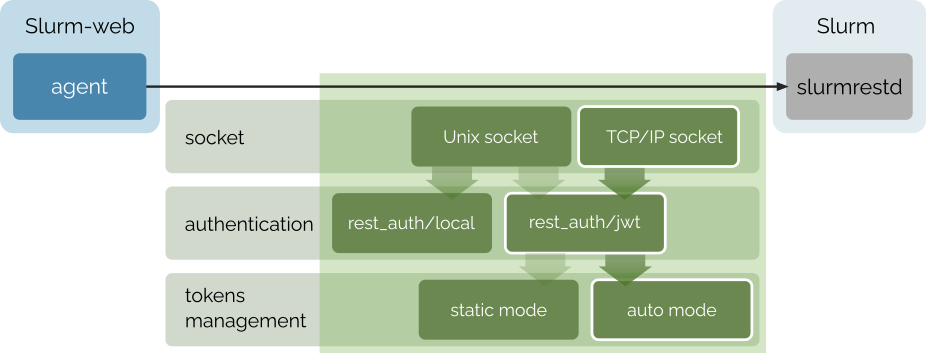Slurmrestd Access

Setup Slurm
With jwt authentication method, the client must provide user and token in HTTP
headers. Then, slurmrestd service forwards these credentials in RPCs to
slurmctld and slurmdbd which are responsible to check expiration and
signature of the token .
In this configuration, slurmrestd service and Slurm-web agent can run with
unprivileged system users.
Create /etc/systemd/system/slurmrestd.service.d/slurm-web.conf
drop-in configuration override for slurmrestd service:
[Service]
# Unset vendor unit ExecStart to avoid cumulative definition
ExecStart=
Environment=
ExecStart=/usr/sbin/slurmrestd $SLURMRESTD_OPTIONS -a rest_auth/jwt [::]:6820
RuntimeDirectory=slurmrestd
RuntimeDirectoryMode=0755
User=slurmrestd
Group=slurmrestd
DynamicUser=yes
With DynamicUser=yes, systemd creates a transient slurmrestd system
user during the lifetime of the service and executes the daemon with this
unprivileged user.
|
Reload systemd units and enable the service:
# systemctl daemon-reload && systemctl enable --now slurmrestd.serviceGenerate random Slurm JWT signing key with restrictive permissions:
# dd if=/dev/random of=/var/spool/slurm/jwt_hs256.key bs=32 count=1
# chown slurm:slurm /var/spool/slurm/jwt_hs256.key
# chmod 0600 /var/spool/slurm/jwt_hs256.keyEdit main Slurm and SlurmDBD configuration to enable JWT alternative authentication:
AuthAltTypes=auth/jwt
AuthAltParameters=jwt_key=/var/spool/slurm/jwt_hs256.keyRestart slurmctld and slurmdbd services to update configuration:
# systemctl restart slurmctld slurmdbdSetup Agent
Copy Slurm JWT signing key and restrict permissions to this copy:
# cp /var/spool/slurm/jwt_hs256.key /var/lib/slurm-web/slurmrestd.key
# chown slurm-web:slurm-web /var/lib/slurm-web/slurmrestd.key
# chmod 0400 /var/lib/slurm-web/slurmrestd.keyEdit Slurm-web agent configuration file /etc/slurm-web/agent.ini to
enable JWT authentication method:
[slurmrestd]
uri=http://localhost:6820
auth=jwt
You can optionally tune lifespan of token generated by Slurm-web with
jwt_lifespan configuration parameter (default: 3600 seconds, ie. 1 hour).
|
To improve security, edit Slurm-web agent service to run as unprivileged slurm-web system user:
-
With native services, edit agent service settings:
# systemctl edit slurm-web-agent.serviceAdd the following lines:
[Service] User=slurm-webRestart the service:
# systemctl restart slurm-web-agent.service -
With production HTTP server, edit agent uWSGI service settings
/etc/systemd/system/slurm-web-agent-uwsgi.service:--- a/etc/systemd/system/slurm-web-agent-uwsgi.service +++ b/etc/systemd/system/slurm-web-agent-uwsgi.service @@ -6,7 +6,7 @@ # By default, this service runs with slurm admin user for local authentication # on slurmrestd. When slurmrestd is setup with JWT authentication, it is # recommended to change this value to more restricted slurm-web system user. -User=slurm +User=slurm-web RuntimeDirectory=slurm-web-agent ExecStart=/usr/sbin/uwsgi --ini /usr/share/slurm-web/wsgi/agent/slurm-web-agent.iniReload service units:
# systemctl daemon-reloadRestart Slurm-web agent:
# systemctl restart slurm-web-agent.service
Test Access
To test Slurm-web agent and slurmrestd service configuration parameters, you
can run slurm-web-connect-check
utility. It tries to send HTTP request to slurmrestd with Slurm-web agent
configuration parameters and reports the status. For example:
# /usr/libexec/slurm-web/slurm-web-connect-check
✅ connection successful (slurm: 24.11.0, cluster: hpc)